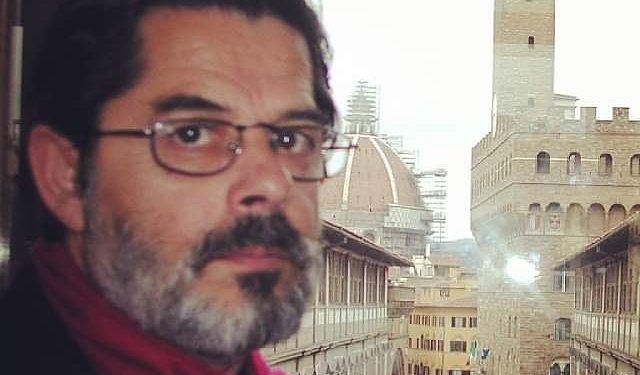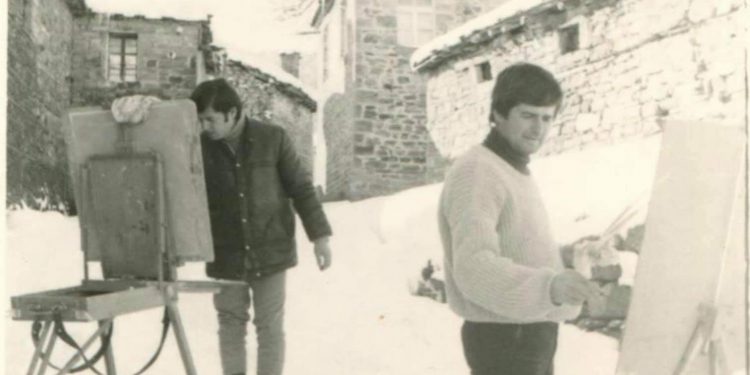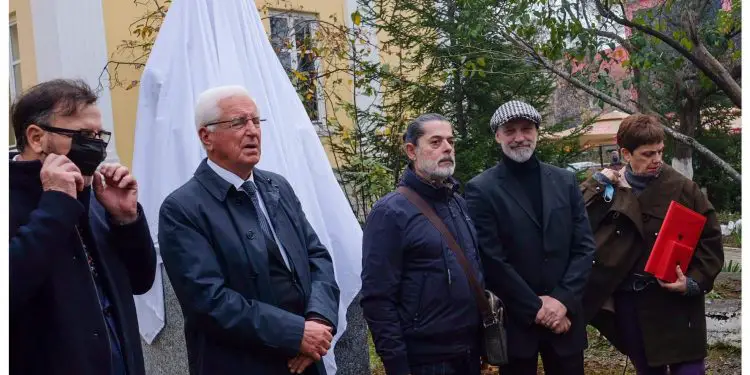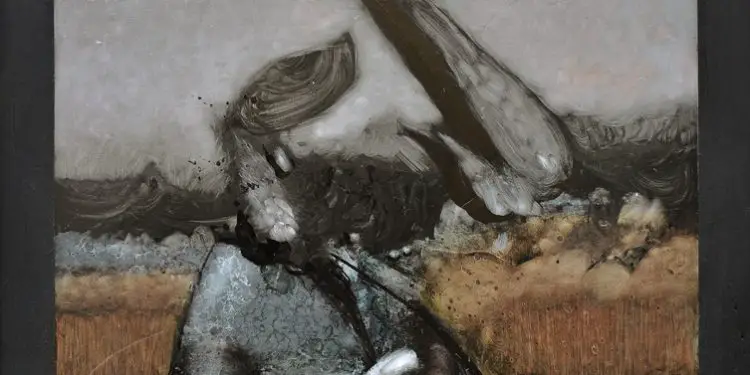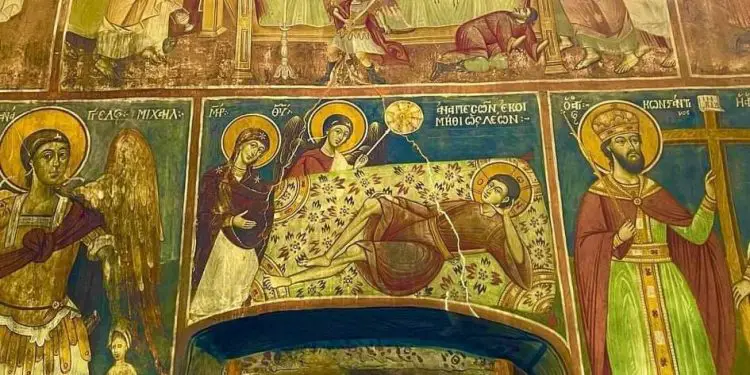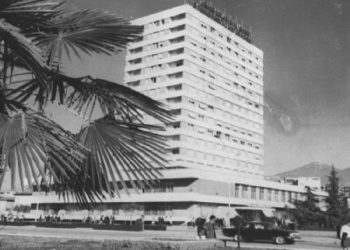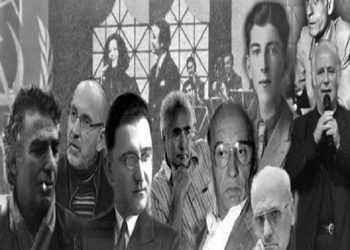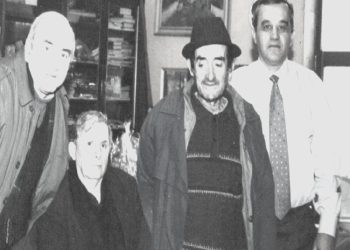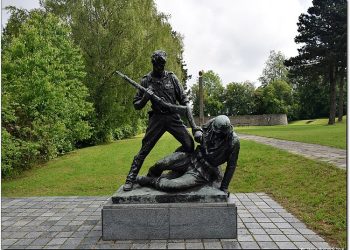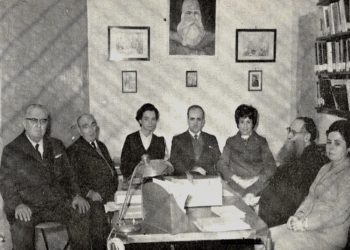
Fatos Kola, sculptor
In memoriam, a few days after his sudden death
Memorie.al/Separation from the life of the painter Mustafa Arapi caused a deep pain to family, relatives and friends, but also a premature and irreparable loss for Albanian iconography and painting. These are areas where contributions, qualitative theoretical-professional contributions and especially innovations, qualify and hierarchize it to the most prominent personalities of national art and culture.
With Mustafa and his wife, the sculptor Hatixhe (the famous zyshë Xhixhi, who is known all over Tirana as a prominent teacher and discoverer and cultivator of talents in the former Pioneer Palace), I had the good fortune and honor to meet him since his student years. I make friends with them.
I was attracted to Mustafa by his kindness, simplicity, self-control, modesty, full of virtues and features that characterized him.
I liked the velvety look, the softness of being, the warmth of timbre and sensuality, which aroused respect and encouraged you to make friends with this peaceful and generous man.
In short, Faja was a noble tyrant who was liked by all and offered only high human values.
The severity of the system, the tragic times, and the extremely slippery terrain of the visual arts world could not even change Faj, endanger, or intimidate others.
Babacan, fragile, meditative and introspective, he promised the classic prototype of the artist with the watchdog and researcher cloth, always floating in calm waters, away from the mud and quarrels that often victimize artists.
The re-establishment of our contacts as lecturers of the Academy in the early ’90s and especially the joint 3-week exhibition in the Netherlands in 2002, enabled us to get to know each other more deeply and exchange academic and professional views.
Undoubtedly, Faja had gone far in theory, had become a genuine scholar and elite expert in the visual arts of Antiquity, the Middle Ages, Byzantium and the Italian and European Renaissance, up to modern and postmodern art. These theoretical pearls, among which in Faja shone full of light Albanian Byzantine Iconology and Iconography, as the pinnacle of world iconography, pollinated and conceived among the Illyrian-Arbërs within Byzantium, this cultural and political empire where we Albanians participated during the 4th-15th centuries After Christ.
Byzantium collapsed as a political empire in 1453, but as we know, the Byzantine spirit in Orthodox culture and religion continued to survive in our southern lands. Already this survival was realized through the constellation of great artists, culminating the famous Byzantine painters of iconography, who projected their genius works on the objects of the cult of the Orthodox faith. Objects which the new Ottoman Empire did not demolish, which gave the constellation of our Byzantine painters the chance to realize their artistic, cultural and patriotic mission. In other words, the Ottomans did conquer Byzantium militarily and politically, but “they conquered it culturally.”
In antithesis and contrast with the Ottomans and the communists, Mustafai spoke to me with pain and passion about the fact that Albanian painters, including himself, these descendants of the genius Onufri did not have the fate of Byzantine grandparents under the Red Empire, especially after 1967.
Mustafa, who knew the history of art and the history of our people very well, made clear the paradigms and differences, and even started talking to me with superlatives about the enlightened intellectual Gani Strazimiri, who in the position of director of the Institute of Cultural Monuments did the impossible to save this genius legacy from the collapse that followed the barbaric campaign of February 6, 1967.
After saving a lot, according to Faye, Strazimir had secured funds and organized the preparation of specialized groups of restorers, which included Mustafa, and later his daughter, an academic painter, Mirela. Strazimir had intensively trained these groups and specialized them even abroad. Thus Faja, this follower of Gani Strazimir, felt proud to have been positioned as a missionary to deliver and save our Byzantine heritage and that of religion and culture in general, which included cult objects: Catholic, Islamic, pagan, as well as architectural heritage values…
My and Faja’s contacts with the legacy of hundreds of genius Dutch painters of the years 1400-1900, of whom over 20 are considered among the greatest in world art – made us aware of the core values of our Byzantine heritage, which we both knew very well.
On behalf of Faja, who is no longer alive, today I have the opportunity to express my deep gratitude to our former ambassador to the Netherlands, the prominent diplomat Mr. Qirjako Qirko, for the excellent 3-week reception there, as it was made available to us and opened all the doors for the exhibition and enabled us to contact the most prominent Dutch artists and visual arts scholars.
Faja was presented in The Hague with a solo exhibition that included a graphic cycle on Albanian legends, while I with the cycle in plural material sculpture, entitled “Divine Love”.
On the opening day of the exhibition, Mr. Qirjako Qirko invited the entire diplomatic corps accredited to The Hague, as well as the entire professorship of the Amsterdam Academy, along with dozens of local art, culture and painter and sculptor officials, who participated without exception. highly appreciated our exhibition.
In this extremely elite environment, Mr. Qirko also moderated our exhibition, which was also covered in the participating media.
In this activity we found that Mr. Cirko enjoyed undisputed respect among fellow diplomats and official Dutch authorities. He even made it possible for us to visit the most famous Dutch museums in the three main cities: Amsterdam, Rotterdam and The Hague, where he personally accompanied us.
Such conditions and presentations with Dutch art and culture Mr. Cirko had previously created well-known Albanian artists from all fields, as he had thus become a true ambassador of Culture, representing and presenting with maximum quality and dignity the national culture, Albania and its prominent artists.
At that time, the main topics of our discussions in the Netherlands were: Aesthetics as the philosophy of art and the evolution of art theory especially during the 19th and 20th centuries, mainly through alternative discursiveness and paradigms in the context of theoretical-philosophical conceptual transformation; The dehumanization of art in communism by the dictates of the state and in capitalism by the greed for profit; The crises of Art as evidence of his growth during the pilgrimage through the difficult path he traverses; “Death of Art” as a result of crises, misunderstanding and ignoring its capital importance for the individual and human society; Dialectics of Artistic Form; The great importance of preserving the structure and integrity of art, as well as the techniques of artistic production in the conditions of technological modernity and reproduction for profit, pushing and throwing art into the clutches of consumerism that destroys the uniqueness of the work of art, thus transformed in multiplied consumption commodity that satisfies the tastes and whims of uncultured social bands; The anti-aesthetic character of postmodernity in art; Aesthetic reflection within the boundaries of the disciplines of the study of creation and the artistic product; The relationship between artistic creation as a transcendental product and a reflection of the spiritual world, despite the moroccan fantasy that stems from the irrationality of the diseased psyche of diseases and drugs, which pushes the “artist” to drive to the pseudoart; The importance and evolution over the millennia of signs, symbols and symbolism, to arrive at Symbolism as a stream of art; The influence of formalism and structuralism as the most promotional representative directions and currents in twentieth century art theory; as well as endless discussions especially on the favorite topics of the Byzantine Mustafa, such as: Relationships between Abstraction, Spirituality and Spiritualization in Art; The role of religious belief, Divine and Mysticism in the arts and especially in the visual arts; The symbiotic relationship between Iconography and Iconology; Tasks and boundaries of Iconology, etc ..
This exchange of views mentioned above began as a reflection of the pressure and challenge exerted on us by the genius of Dutch painting of the 14th-17th centuries, centuries in which this country had given birth to only genius painters. As sons of the genius Onufri with friends, facing the genius Dutch painters, we were extremely emotionally charged and intensively and constantly exchanged views with fellow Amsterdam academics, who respectfully invited us to visit their academy.
We acquaint our colleagues with our ancient genius past, and especially with the bright Byzantine era, and they acquainted us with the problems of academia and the developments of contemporary art in the Netherlands and beyond.
The debates on these topics and the closeness of attitudes strengthened the friendship and mutual trust between me and Mustafa, and the strongest point of unification of our views on the Byzantine iconographic art we adored, was the common conclusion that: The highly sophisticated aesthetic essence of This art had its beginnings in Byzantium (ie in the Albanian lands), to culminate in Europe during the Enlightenment period, which in terms of the delivery of artistic criticism, precisely this supersophisticated essence through the spirit and means of expression of internalized in Byzantine Epochal Art, made it extremely difficult to decipher values and their deserved hierarchy through criticism, even if it is specialized … And for both of us this conclusion-product of a logical operation meant that the world and artistic criticism of hand and would continue to have difficulty in identifying, structuring and determining the range and size of the iconographic value format Albanian Byzantine tribe as the highest peak and crown of Byzantine art and the whole world iconography. We even agreed with Mustafa that the world center of Byzantine iconographic and iconographic studies had no reason not to transfer to Albanian territory in the future, as long as the Orthodox Christian world has not yet produced greater than our Onufri. And this is evidenced by the facts (artifacts of reality), which would undoubtedly serve as an impetus for UNESCO, one day to support it with projects and to finance this relocation.
Mustafa then addressed many of these topics and views in subsequent theoretical writings, for which I am personally grateful.
With its irreversible loss, Albanian academism, Iconology and Iconography, along with the national school for the restoration of our masterpieces of Byzantine art, suffered a devastating blow and all the achievements and projects of Mustafa Arap remained on the road.
Thus, the national culture is losing at a frightening pace the very values of the artistic and spiritual heritage and the Albanians are losing the most valuable asset of the epochal arts that we delivered as long as we were part of the political-cultural empires with world cultural radiations.
Mustafa Arap’s Byzantine experiences, studies and research were lost forever, as we now have no one left to have his knowledge and power. Even the Albanian school has finally lost the chance to produce aesthetes and researchers and restorers of the upper level of the prominent Byzantine Mustafa Arapi.
It seems that fatality and tragedy have eternally doomed Albania to its Byzantine heritage, as long as state and academic policies are lacking to keep alive the academic iconological knowledge and the brilliant cultural and iconographic assets, which we have the most culminating in the world in terms of superiority. exalted in genius. Thus, our tragic fate, even with our help, is done with the future neighbors of this heritage, which unfortunately have taken over our Orthodox churches, where are located most of the most valuable assets of the Byzantine heritage (mainly icons, iconostasis and murals and paintings, which are being robbed, abandoned on purpose, and demolished every day and more).
As for the academic teaching policies and the delivery of restoration techniques in relation to Byzantine art, it would suffice that the alarm in the Academy of Arts of the post-1990s would start alarming if it was announced that prominent scholars Mustafa Arapi and Gjin Varfi were approaching.
From now on, our visual arts students will not even be able to know more about the Byzantine genius art we have inherited, except for 4-5 names of our painters who amazed the planet, while their mural works are disappearing one by one…
This was and will remain the greatest drama of my friend Mustafa Arapi, which makes his tragic loss even more painful, as he parted from us with the great hostage of the fall of his Byzantine ideals, right at the height of maturity. and wonderful and numerous professional feeds. We lost him when he was giving so much, as if he was rushing somewhere …
***
The endless cycle of scientific, didactic and professional contributions of Mustafa Arap gradually rises and culminates sensationally in the time span of 4 decades (1980-2020).
Her brightest flashes tell us that this unique personality of our visual arts is widely displayed as a co-author of academic texts, author of scientific monographs and lecturer of dozens of scientific studies and professional-journalistic treatments in research institutions, scientific activities and the media. numerous, at home and abroad. Excluding theoretical-academic contributions as a lecturer at the Institute-Academy of Arts, as a lecturer at the School of Restoration, as a contributor to the discovery, scientific evidence, subsequent restoration, museumization, exhibition, promotion and theoretical publication of many masterpieces of Byzantine iconography, or in contributing to the compilation of catalog texts and the promotion of exhibitions and feeds of painters’ colonies in the visual and journalistic media.
Therefore, Mustafa is deservedly appointed: Head of the Department of Byzantine Art and member of the Scientific Council of Restoration at the Institute of Cultural Monuments, Tirana; member of the High State Commission of the Albanian Postage Stamp; member of the National Council of Restoration.
Mustafa Arapi is the author and co-author of projects and personal restorations of icons of genius painters of Albanian iconography, such as Onufri (father), Nikola Onufri (son), Onufër Qiprioti, Kostandin Shpataraku, Joan Athanasi, Çetiri, Kostandini and Athanasi from Korça.
He is the author and co-author in the restoration of iconostasis, murals, frescoes, church ceilings and an infinity of objects and buildings considered as valuable cultural heritage monuments throughout the country.
He is: author and implementer of exhibition projects of masterpieces of Albanian iconography in museums of Albania and iconographic exhibitions inside and outside the country; is the winner of high awards and decorations for scientific and professional contributions; He is the author and co-author of endless painting exhibitions, individually and in groups, inside and outside the country, where he is also known for the numerous awards he has won and the high ratings from professional circles and media networks.
So, if we metaphorize, we can say without fear that the study and professional activity of the artist Mustafa Arapi have already turned into a glittering galaxy within the universe of Albanian visual art.
The body of work he left behind is a synthesis of worldviews, knowledge and worldviews on the cultures, philosophies, ideas, concepts and theoretical discourses of our visual system.
The trajectory of his activity and the range of theoretical-professional interests convey the message that Mustafa’s perception of the world is not always the same, because he has changed towards value exaltation, influenced by different political philosophies, education and experiences for two worldview times. aesthetic-philosophical within the history of his life.
His creative and scientific activity are bangoprova where he was cultivated and matured in nearly half a century of intense artistic life.
The product of Faye’s creativity is so sharp that it emits the conclusion that his senses, eye, and mind appear to us impregnated with a complex visual system. And it is here that we notice that the visual world researched and created by him is filled with the must and meaning of ideas and concepts designed on richly transfigured squares full of realistic and often abstracted figurative directions …, where illusory transfigurations make plurality of objects and objects immersed in visual metaphors, to reveal to us ideas that have never been perceived and conceived in this way before.
If we observe the beginnings of Mustafa’s journey in the world of creation, we find that he relies on the description of the surrounding atmosphere. This is observed in both graphic and color landscapes, where they always prefer feelings and reflective means with which he describes reality in a strict and detailed way … Similar to a pedantic and scrupulous chronicler, who emphasizes not only themes, but also to language and means of expression to capture in a visual impression the affirmation-forging of a moment on paper or canvas. And this just under the rhythms of loose paintbrushes full of bright tones, which focus specifically on it to give a special value to the light. Thus, the author gradually clings to the aesthetic treatment of color as the main protagonist towards the personalized and strongly expressed vision through it. Therefore, optical phenomena captured with fast notes and taken directly from nature, become the search for the expression of expression, where dense brushstrokes and strong colors manage to distort reality.
It is at this stage that coincides with the decade 1990-2000, we notice that Mustafai has been significantly influenced by concepts and artistic currents such as impressionism, neoromanticism, magical supernatural, metaphysical, surreal realism.
We even find the influences on him of these currents of Realism emitted in the works of direct landscapes taken from nature, as well as in those modified in his studio-laboratory.
Later in Mustafai we notice new elaborations of the language and the system of discourse, such as the static tonalities that come by calming the harmony and the color timbre, where the rhythmic irregularities strongly enrich the inner movement under the illusion that everything is moving towards explosion.
In another cycle of landscapes we notice that Mustafai reveals an added attention to the composition and constructs it with a chromatic scheme with a chord of three large spots, which are emitted to us as three threads that wear the landscape …, already under the shadow rite- light-shadow, where the light is focused mainly in the center, both for placing shadows-light-shadows in the horizontal composition up-down on the picture, as well as for the vertical one from left to right, as well as for the diagonal slope from one lower edge of the square to the other opposite edge. Subsequently, all three tissue sectors undergo internal color counterpoint processing within the stain family to enliven them in all three sectors, but in all cases the light centers are more explosive.
In these squares we notice that color is perceived more subjectively and personalized as a selection of codes of its palette, so the color chord has undergone a pre-processing becoming conceptual. While the processing within each chord stain is left to intuitive and spontaneous improvisation, down to the most intimate spots.
In the elaboration of the detail we encounter the preference of the fantastic, where reality is distorted by enriching the image with emotional and expressive values independent of nature.
At the peak of professional maturity of the last two decades, in his creative range there are a series of works inspired and built on the basis of the principles of Byzantine mega-culture … Principles which through optical illusions turned into visual aphorisms prove us that the Albanian Byzantine past in Mustafa’s visual art cannot be so easily set aside and then regained in focus bash through the protagonist-main theme and aesthetic object of the world of religions and Christian culture, such as Christ.
Even Jesus, this collective reality-myth, not only in the study and scientific works and the restored ones …, as in the icons of the great Byzantine painters, but also in the paintings created by Mustafa, as he chooses to treat and paint …., always He, that is, Jesus-king, God and Son of God, always appears in a state of solitude and has a solitary appearance … A scene where sometimes he appears to us with the sufferings of the violence exercised on him, and sometimes he appears to us as a triumphant one who speaks to him time.
After the violent denial of Christ by the communist ideology, after the early ‘90s to the painter and scholar Mustafa Arapi a natural interest was born for the individual and the believers who had lost the paths of connections with religious traditions. Therefore, Faja liberated from tutelage is feverishly involved in studies and creations based on this spiritual resurrection.
The time had come for systemic transformations to be accompanied by thematic innovations and expressive techniques in our culture and visual arts as well. Therefore, even in Mustafa’s creations we find mostly this transformation, mainly in the genre of landscape, where he deals with motifs that range from those of an idyllic nature, to the conventional ones of a historical-memorial character, including those that represent the transformation of urban landscapes inside and outside Albania. These landscapes are often presented in the form of Denunciation and Provocation, these two main currents of Conceptual Art.
Color-form as a basic element of expression and visual communication in painting, which uses appearance instead of words, appears to us full of variety of attitudes in Mustafa’s works, where the artist introduces us to the natural landscape that is being transformed into an urban landscape, which resembles a chaos throughout the Albanian territory.
His “denouncing” landscapes acquaint us with traditional construction materials and techniques, but also with modern ones used without criteria, far from solutions that are affected by ideal measures of space and volume in relation to the function …, where space stands out and objects placed in the cacophony, where man is not only unable to meditate, but is often found in alarming and extremely stressed situations.
As we consider this mission of conceptual art, grasped and broadcast by Mustafa, this whole corpus of works had to be refined through language and visual laws enriched with the direct influence of modern and postmodern art.
But has Mustafa been able to create an individual language within the universal one through the expression of the concepts and systems he builds in his work? Has he succeeded in carrying out the spiritual transplant with these concepts and systems in order to clearly express the feelings and truths according to him? Does his monologue create chances for a unique and unrepeatable dialogue with our souls? What is the arsenal of tools that enable this dialogue of feelings and ideas?
Initially, in my journey within the world of Mustafa’s works, I am trying to expose to the public with professional cultivation and beyond, some of the essential features of visual systems and language that have maintained coherence despite changes in time and space, as a basic requirement this for every artist, on his journey within the art world. Therefore, stopped in front of the corpus of his works, I find that: Mustafa’s works embrace a wide range of concepts, starting from Realism, with all the developments within it, to the abstract concepts of the currents of Realism.
Often his works arise from references to formal concepts, or ideas within which we must distinguish whether there is the presence of his “I”, or have we obtained the next stamp, according to the conceptual matrix embedded in the head? Therefore, we have to solve the dilemma: Do we, in these amplitudes of reference movements, preserve homogeneous features, or do we only have new formal solutions? And we have the right to reason and formulate this as we acknowledge that Mustafa lived and created in times of great transformations of social and artistic ideas … Especially since the artistic world in which he lived was full of dangers in terms of the normal development of aesthetic events: first from the imposed social-realist dogma in the first decade, after his completion of the academy (ie the years 1980-1990), and then from his suffocation and between his vicissitudes in freedom, during the next three decades 1990-2020 .
Anyway, from the very beginning I have to admit that Mustafai had an academic background as a graphic designer. We even need to note the way a graphic artist sees the visual world within the laws of art, where the graphic concept precedes other visual aesthetics events.
From this examination we ascertain the following phenomena: It is the strong graphic contrast that dominates in his works, enabling the figures to emerge with force, already shaped with frenetic counterpoint points, which create the appearance as if they are exploding.
This feature is preserved not only in the works in graphic techniques, but also in the whole corpus of colored works, while the color in him again preserves strong visual perceptions and where they always enliven and shine.
The color configurations built by him can be divided into two stages; a) The first period appears with the harmonic counterpoint within the color families, given with stabilized state and equilibrium. In this period Mustafa is preoccupied with the approach that in his works the law of harmony within a world of opposites dominates, always able to create a unified vision. b) While in the second period in his paintings we encounter colors that explode especially in their center, realized with the color gradation system in descending circular pattern, vertical up-down, horizontal left-right and crossed … By caused these frenetic color centers to and fro to be gradually surrounded by quiet oases that transfigure the appearance of a “bing-bengu” exploding and hovering in suspended space.
The centers of his paintings appear as a figure that contracts on the extreme backgrounds of the square creating dual-view schemes. These experiences gained from the painters Dali, Vazarel and Escher, who have successfully researched this perceptual-visual phenomenon of the dilemma between the figure and the background. This illusory phenomenon created by the forms of central figures, which are not closed in themselves, but are unfolded in space.
Mustafa realizes this conceptual approach through the contrast of colors, or from the contrast of surfaces with different characteristics.
His figuration appears quite rich in relation to the illusory boundaries of imaginary figures that come as abnormalities and seem to emerge from nothing to occupy empty surfaces of incomplete forms.
Prominent in his paintings are the unreal, absurd, often disturbing and anxious images …, often emphasizing the fantasy, the world of dreams and the liberation of the unconscious away from any connection with the rational, but preserving the figuration, i which in other pictures sinks into abstraction without a trace of reality. He realizes this approach through compositions with asymmetrical structures, which add drama to the image, emphasizing the breaking of the rule and the violation of balance.
In the end we can say with full mouth that Mustafa has managed to modernize the images on the themes of the Christian religious tradition, freely reinterpreting these themes with new expressive visions.
In Faye’s works a significant role is played by the enrichment of the image with the data of depth for the two prevailing concepts for perspective: Be it that of the Byzantine perspective, richly exploiting the optical illusion of loss of perspective, where the figures feel flat and less volume in a two-dimensional space, be it those of the Renaissance art perspective, whose events took place mainly in Italy and in Western Europe with all six forms recognized by professionals by the way our eye perceives objects and backgrounds in nature , such as: 1) Shadows – the area in the shadow opposite to that in the light on objects that help us to understand the shapes of a solid object (its own shadow), as well as the shadow that the object projects on the supporting plane. 2) Size – where nearby objects look larger than those far away. 3) Overlap – objects in front of them hide behind them those objects that our eyes would partially perceive to be behind. 4) Density – the greater the distance from us, the smaller the objects appear to us, always overlapping or close to each other. 5) Colors – objects in the background are less vivid than those in the foreground and are perceived as cool, while objects in the foreground have dense and warm colors. 6) Deformation – is an illusion created by our perception, which sees objects as they decrease in size, the deeper they are … As e.g. buildings, trees, roads, tiles, etc …
All these depth data were discovered and used by painters from the 1400s onwards, to communicate the idea of the third dimension of objects and space.
In this illusion of perspective, lights and shadows alternate creating an infinity of clarity and darkness.
This wealth of tools and visions, not only characterizes all his creativity, but also proves to us that Mustafa has a deep knowledge of the new experiences he brought: Informal art; optical art and that of various currents of abstraction in the twentieth century, for which experts and critics agree that they manage to suggest and create strong feelings of depth.
Careful consideration also helps us to perceive that the experiences of kinetic-visual and gestural art have a strong influence on Faye’s work. These concepts that have modernized the techniques of realization and have become the uterus that has given birth to phenomena of these new styles, which manage to suggest strong sensations of movement even without presenting elements of the outside world.
This instrumentarium, rich and effortlessly mastered, makes Mustafa stand out for a visual language rich in varieties, thanks to the cognitive culture on these visual phenomena, compared to his mastery to organize all these elements in composition, even in endlessly different combinations.
Mustafa’s endless dialogue and communication with epoch-making arts, schools and creative currents and techniques infinitely enriched through experimentation and creative laboratory, over the decades have enabled him to evolve views, both for graphic and color concepts. Even regarding the color, Faja has extremely elaborated his favorite palette, where light colors stand out that express enthusiasm, spiritual purity, the desire to be understood and liked by others, at the same time extremely seductive for him torn good and positive forces.
Blue, green, viola, okra, purple maroon, pink and white – are motivated within his squares mainly in landscapes with healing and reviving power, which show depth, generosity, wisdom … These values that in addition to masterful use of pairs of contrasts, help us to obtain images where colors stand out to the maximum, creating a state of overflowing nature with the image of revival and transformation.
Red and orange in his works are colors that stand out and strongly attract attention, creating and underlining their energy, power and authority in relation to other colors. Thus, Faja appears to us as a painter who desires and attempts strong experiences. He even, through the colors-light, like yellow and orange, animates and happily spreads his messages.
He is aware that with them he re-calls and emits to the viewers something precious and worthy of worship.
These technical-professional convictions were obtained and consolidated in him through personal experience, during the in-depth study and restoration of churches and icons of medieval Byzantine art, works which have a golden background, which strongly connected Mustafa with the ideas of Byzantine painters. according to which the maximum of divine light and illumination is located right in the sky, where the House of God itself is located.
It is precisely these ideas-images that have strongly influenced Mustafa to enrich and transfigure in his works his concepts on color, revealing himself to us as a painter who respects the tradition on faith and the divine act related to man and natural phenomena.
Mustafai successfully uses his own color palette in paintings with symbolic meaning. While he paints pictures with denouncing dramatic content, he prefers to shape them with tonal variations of grizzly, accompanied by counterpoints of white and black, always with the aim of underlining the state of protest, emotions of fear, depression, lack of life, loneliness, coldness, loss and tragedy.
Faj’s paintings are attractive thanks to his ability to organize structures composed on the basis of criteria that perceptually support the appearance, such as: weight, lines-strength and rhythm.
Compositional larchs are molded in Faja thanks to the relaxed and efficient discourse regarding weights where he only by shifting the weight defines a different type of composition, from which we obtain different meanings. Therefore, we often find in his paintings the weights placed in the center of the image, or straight down, as they communicate stability and make the composition more stable. But, as I pointed out above, in his quest to modernize religious themes, Mustafa succeeds in causing us strong emotions with compositions where weights are shifted upwards, from which instability, unstable equilibrium is obtained. and full of dynamism precisely because it seems to us as if weights have broken the force of gravity.
If we add to these the sloping, broken force lines, as well as the very arched and asymmetrical lines, with which Mustafa intends to impregnate his compositions, the resulting images seem to be exploding and right there we feel the effort of Sisyphus who has seized his being in the torrent of momentum to stabilize the connections between the parts that make up the composition, in addition to the commitment to cope with the alternating rhythms of color and the galloping knock of the brushes that make the work look like it was under unbearable weights and given the density of tools that express frantic emotional outbursts.
The essence of the world of creation is the aesthetics of the different, of the unexpected, of the blissful …, where the form is exalted and becomes the power of a free and unconditional beauty. Therefore, the monologue constructed by Mustafa in his paintings, creates with our souls a unique and unrepeatable dialogue, full of life and truths told with clear directions of aesthetic-philosophical convictions. Mustafa even manages to easily ignite any soul that encounters his paintings, as through color sentences he captures the essence of the soul and makes it feel and rhythm under condensed emotional states.
His studies of Byzantine art have prompted Mustafa to appear open to cultures, like the magical Byzantium he internalized and helped create a visual world where the harmonization of opposites within a unified vision and the sense of unity within a representation were the basic philosophical concept of their universe.
But above all, Mustafa Arapi had the merit to present this culture to us, both from a scientific point of view and from an artistic point of view. He even explored this culture of genius as a basis for knowledge of beliefs, but mostly stopped at this culture: to explore the alternatives it unfolded in the world of aesthetics; to explore the uniqueness within world art related to the concept on the artistic figure; to absorb and internalize the alternatives and innovations of the creative spirit in space and in the whole time of the art world, as a basis for the knowledge of our historical-cultural substrata and our worldview orientation towards the future.
The legacy and theoretical-professional contributions of Mustafa Arap’s work are a synthesis of the indisputable conviction that the Albanian cultural environment in the epochal arts, like the Byzantine one, was created by “bing-beng” dividing the crossroads of Eastern and Western cultures, where the dialogue of epochs has shaped the cultural star of our ancient civilization.
Therefore, Mustafa, as the animator of the work and its major contributions, informs us that the centuries-old values of art have objective content due to its transcendental origin and that they are not considered merely as subjective and arbitrary products of “Un”, even for due to the fact that the art world, unlike other worlds, deals with the sublime, with the eternal.
Along the path of searching for the discovery of enigmas and the liberation of forms of expression alongside Mustafa’s masterful and artistic evolution, we note that the foci of inspiration after the 1990s he found outside the temporal and spatial frameworks of Socialist Realism. His work tells us that it is no longer the repetitive figurative, referring to an aesthetic model that casts a shadow over itself, but is the plurality of aesthetic models of epochal arts dissolved in the world culture he researched, which ultimately helped that to enrich the artistic figure endlessly with visions and emotions.
His work is no longer subject to the ideological ideology that spoils the taste of the unique experience.
His masterpiece, the figurative composition “The Throne”, is the creation where Mustafa’s reformed concepts are clearly visible, where tradition and innovation creatively restore dialogue.
This work suggests with some visual elements one of the pioneers of visual perspective in the art of the Italian High Renaissance, the Florentine Paulo Uccello. But in many other elements it sounds transformed.
Conceived and shaped with a clever allegory, the work in question creates a figuration similar to the influential subjects of mythology and branches the fantasy into the creation of the legend about the One (God), without even displaying it at all, wears the attributes of fantastic beings , cult or deity, who have
as their destiny only the Throne, which awaits them to appear. This is a language of signs abstracted in metaphysical sensory metaphor …, it is a subjective reality of intellectual experience.
The metaphysical emptiness of the center (Throne) is extremely disturbing and full of nightmares. The silence that hangs in the surrounding air is the silence that invites us to love what is to come, which will definitely be in the role of the sword-leader “king”.
The work strikes the psyche and memory. It is a successful attempt to find artistic expression, which penetrates the dilemma that deepens the mystery …, and this is seen in the representation that Mustafa makes of the human figure, which he transforms into a cheeky but conscious mannequin of a a crowd that has many heads but only one brain stopped in anticipation of His coming, the “one” —the ghost, representing power over them.
A chair-throne and an abandoned sword indicate the presence of someone who has left and is expected full of anxiety and reverence that he will come …
The atmosphere created with light colors in gold, radiates strong graphic and coloristic counterpoint between the sunny oasis of the Throne that folds into thousands of particles scattered over the spears and flags, but that folds into silver over the shields and metal suits in dark gills, which they wear head and feet the caloric Christian figures of medieval Europe, waiting with reverence in upright position and with their feet on the ground, around the Throne, which looks like a self-contained body, motionless and absolutely silent.
This way of presentation takes on an expressive and symbolic meaning within a language of transcendental and metaphysical figuration.
The works of Mustafa Arap come to us as images that are involved in an uninterrupted aesthetic and spiritual dialogue within the world of visual art and that make the author stand dignified among the great forerunner and contemporary masters.
The dialogue where he tears and participates, enables him to express his “Un” cast in dozens of cycles and works realized in many of the techniques of graphics and other sectors of the language of painting.
This valuable heritage brings us closer to his spirit projected on works full of triumph.
His soul wandering among us reminds us that Mustafa managed to painstakingly mark, color and face his own heavens.
You rested eternally in eternity and in the peace, you loved so much, my unforgettable friend.
Tirana, February 15, 2021
Memorie.al




